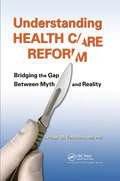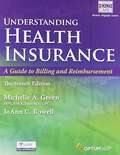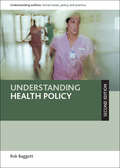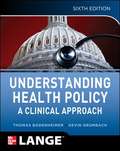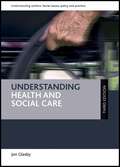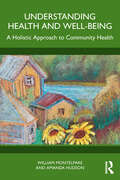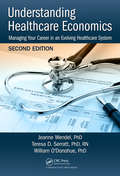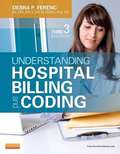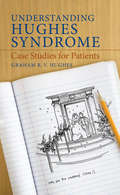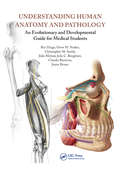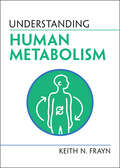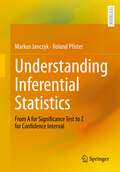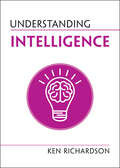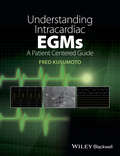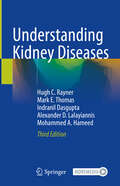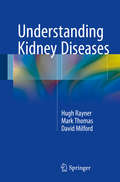- Table View
- List View
Understanding Health Care Reform: Bridging the Gap Between Myth and Reality
by MD, PhD, FeldmanAfter nearly a year of debate, in March 2010, Congress passed and the president signed the Patient Protection and Affordable Care Act to reform the U.S. health care system. The most significant social legislation since the civil rights legislation and the creation of Medicare and Medicaid, the bill‘s passage has been met with great controversy. Pol
Understanding Health Care in America: Culture, Capitalism, and Communication
by Michael PaganoThis book examines the current state of American health care using a social science lens to focus on the interdependent, intercultural, economic, and communication aspects of access and delivery. This text explores how the cultures of health care organizations, health professions, governments, and capitalism, as well as communication, all contribute to a disease-focused, economically driven, technology-centered health care system. It seeks to understand 21st century health care from a macro-level view based on historical realizations and the current plethora of interdependent, but self-serving realities that provide few, if any, incentives for organizational collaboration and change. The fact that the most expensive health care system in the world does not provide the healthiest outcomes is a driving force in this exploration. By reflecting on American values and beliefs regarding health care from philosophical, clinical, communication, and cost perspectives, this text is designed to encourage an organizational transformation at every level, from government to providers to patients. This comprehensive survey is an important guide for those studying, or working in, health care professions, as well as health care policy and administration. It should also be of interest to any reader who seeks to better understand U.S. health care policy from social science, economic, and/or health communication perspectives.
Understanding Health Determinants: Explanatory Theories for Social Epidemiology
by Ian McDowellThis book assembles a wide range of explanatory perspectives on social inequalities in health. Everywhere in the world, those with less advantage die younger and suffer more illness than the wealthy. Decades of research have documented this reality and yet we lack a comprehensive understanding of the mechanisms through which social circumstances ultimately influence the biological processes that lead to disease. Explanations have been proposed from various disciplines – economics, psychology, behavioral science, geography, and neuroscience – and each sheds light on parts of the overall process. But very few texts assemble these insights into an overall explanatory paradigm.Through a review of concepts and theories from a wide range of disciplines, the author outlines how these may be woven together to offer a more complete picture of how social influences 'get under the skin' to affect health and disease. As well as understanding individual health, the book assembles explanations for social disparities in health. It concludes with a proposal for a set of explanatory models that cross disciplinary boundaries. Topics explored include:Social Inequalities in HealthExplanation and Causal Models for Social EpidemiologySocial and Economic Theories to Explain Patterns of DiseaseBiological Pathways Linking Social Determinants to HealthTheoretical Models of Health BehaviorWork Environment and HealthSocial Networks, Social Support and HealthPositive Influences on Health: Coping and ControlThe Relationship Between Personality and HealthUnderstanding Health Determinants: Explanatory Theories for Social Epidemiology is a textbook for graduate students in epidemiology, health sciences, health policy, and psychology, as well as social science students who are studying health. It will also be of interest to general readers, and can serve as a reference for researchers in epidemiology and the health sciences who are planning studies of the social determinants of health. The book reviews theories that could be tested in such studies.
Understanding Health Insurance: A Guide to Billing and Reimbursement
by Michelle A. GreenGive students the essential learning tool to prepare for a successful career in medical insurance billing with UNDERSTANDING HEALTH INSURANCE, 13E. This comprehensive, easy-to-understand, updated text presents the latest code sets and guidelines. <p><p>Students examine important topics, such as managed care, legal and regulatory issues, coding systems, reimbursement methods, medical necessity, and common health insurance plans. <p><p>Updates address new legislation that impacts health care, including the Affordable Care Act (Obamacare); ICD-10-CM coding; electronic health records; Medicaid Integrity Contractors; case mix management; hospital-acquired conditions; present on admission; and value-based purchasing. Practice exercises and the workbook (available separately) provide extensive review, application-based assignments, case studies and CMRS, CPC-P, and CPB Mock Exams.
Understanding Health Insurance: A Guide to Billing and Reimbursement 2021
by Michelle A. GreenThis book helps develop the skills and background for a career in medical billing and insurance processing or revenue management. <p><p> This complete resource explains the latest medical code sets and coding guidelines as you learn how to assign ICD-10-CM, CPT, and HCPCS level II codes; complete health care claims and master revenue management concepts. You focus on today’s most important topics, including managed care, legal and regulatory issues, coding systems and compliance, reimbursement methods, clinical documentation improvement, coding for medical necessity and common health insurance plans. Updates address changes to ICD-10-CM and CPT 2021 codes and introduce electronic claims processing, clinical quality language and other developments. <p><p> A helpful workbook provides assignments; case studies and CPC-P and CPB mock exams, while Mind Tap online resources offer practice in CMS-1500 claims and assigning codes.
Understanding Health Policy (Understanding Welfare: Social Issues, Policy and Practice)
by Rob BaggottIn recent years the pace of reform in health policy and the NHS has been relentless. But how are policies formed and implemented? This fully updated edition of a bestselling book explores the processes and institutions that make health policy, examining what constitutes health policy, where power lies, and what changes could be made to improve the quality of health policy making. Drawing on original research by the author over many years, and a wide range of secondary sources, the book examines the role of various institutions in the formation and implementation of health policy. Unlike most standard texts, it considers the impact of devolution in the UK and the role of European and international institutions and fills a need for an up-to-date overview of this fast-moving area. It features new case studies to illustrate how policy has evolved and developed in recent years. This new edition has been fully updated to reflect policies under the later years of New Labour and the Coalition government. Although written particularly with the needs of students and tutors in mind, this accessible textbook will also appeal to policy makers and practitioners in the health policy field.
Understanding Health Policy: A Clinical Approach
by Thomas Bodenheimer Kevin GrumbachUnderstand how the healthcare system works - and how you can succeed in it Covers the 2010 Affordable Care Act A Doody's Core Title for 2015! The most trusted and comprehensive guide to healthcare available, Understanding Health Policy provides everything students and professionals need to build a solid foundation on the field's most critical issues. Expert practitioners in both the public and private healthcare sectors, the authors cover the entire scope of our healthcare system--from the concepts behind policy decisions to concrete examples of how they affect patients and professionals alike. Understanding Health Policy, 6e makes otherwise difficult concepts easy to understand--so you can make better decisions, improve outcomes, and enact positive change on a daily basis. Features: Coverage of structure, organization, and financing of the health care system Key principles, descriptions, and concrete examples are skillfully interwoven in each chapter to make important issues interesting and understandable Clinical vignettes clarify difficult concepts and demonstrate how they apply to real-world situations Comprehensive list of review questions reinforce what you have learned Understanding Health Policy, 6e will help you develop a clearer, more systematic way of thinking about health care in the United States, its problems, and the alternatives for managing and solving these problems.
Understanding Health Policy: A Clinical Approach
by Kevin Grumbach Thomas S. BodenheimerThis book provides everything you need to master the healthcare system’s nuances and complexities, work more effectively with other members of healthcare teams, and identify areas in need of change. <p><p> Written by practicing primary care physicians who are experts in healthcare policy, this peerless guide covers the entire scope of the U.S. healthcare system and draws on lessons from systems in other nations. The authors carefully weave key principles, descriptions, and concrete examples into chapters that make vital health policy issues interesting and understandable. Whether you’re a student, medical practitioner, or public policy professional, you will come away with a clearer, more systematic way of thinking about our healthcare system, its biggest challenges, and the most effective ways of making it better for everyone. <p><p> Features: Covers every aspect of healthcare, including finance, organization, and reimbursement; Delivers updated information on the Affordable Care Act, Accountable Care Organizations, and system consolidation; Provides new insights into the role of social determinants in patient health; Clinical vignettes highlight key policy issues and clarify difficult concepts
Understanding Health and Care Among Sex Workers: Perspectives From Rhode Island (Palgrave Advances in Sex Work Studies)
by Claire Macon Eden Tai Sidney LaneThis book examines sex worker health and the concept of care among sex workers in Rhode Island using mixed methods research conceived of and led by Ocean State Advocacy (O$A), a grassroots collective of sex workers in Rhode Island. Drawing upon survey data, in-depth interview research, as well as ethnographic and grounded theory principle, this text provides a nuanced look at why sex workers face disparate health outcomes, what defines the area of sex worker health, and practices of care that exist among sex workers in Rhode Island. Throughout this book, the authors examine how criminalization and stigma impact care and why sex workers find themselves in a distinctly challenging position when trying to stay healthy and well. Throughout this book, the authors explore both these vulnerabilities and sources of strength among the sex work community with the goal of gaining a better understanding of what sex workers in Rhode Island need for a healthier future.This book will be of interest to scholars and students within the fields of Sociology, Gender and Sexuality Studies, Labor Studies, Public Health, Social Medicine, Medical Humanities, and Medical Education.
Understanding Health and Social Care (Understanding Welfare: Social Issues, Policy and Practice)
by Jon GlasbyThis is the concise, accessible guide for students and practitioners who want a comprehensive introduction to health and social care. Engaging practical features, such as user-focused case studies and reflective exercises, promote understanding of theoretical and conceptual knowledge. In turn, clear explanations of social policy theory help frame the policy and practice dilemmas faced by students, front-line workers and policy makers. Chapters cover partnership working and integrated care, independent living, disability and long-term conditions, discrimination, user involvement and support for carers. This new edition has been updated to cover key developments under the Coalition and beyond, including the 2012 Health Act, the 2014 Care Act, the Francis inquiry, the Winterbourne View abuse scandal, the integrated care agenda and the impact of austerity.
Understanding Health and Well-Being: A Holistic Approach to Community Health
by Amanda Hudson William MontelpareThis textbook provides a comprehensive introduction to the factors that impact physical, mental, and social well-being, offering a broad definition of health and healthcare that moves beyond the biomedical model.Stressing that health is not merely the absence of disease or infirmity, the book addresses a diverse range of issues that influence individual, community, and population health. There are chapters on the microbiome, physical activity, and lifestyle and behavior, as well as the various social determinants of health, health literacy, and issues around mental health. Defining health as a wicked problem (i.e., one that is contested and endlessly complicated) the book provides an international lens which also includes coverage of global health and the impact of climate change.Including key concepts, end-of-chapter questions, and further reading, this is the perfect introductory text for students of public health, health studies, or health sciences.
Understanding Healthcare Economics: Managing Your Career in an Evolving Healthcare System, Second Edition
by Jeanne Wendel, PHD Teresa D. Serratt, PHD, RN William O'Donohue, PHDHealthcare economics is a topic of increasing importance due to the substantial changes that are expected to radically alter the way Americans obtain and finance healthcare. Understanding Healthcare Economics, 2nd Edition provides an evidence-based framework to help practitioners comprehend the changes already underway in our nation’s healthcare system. It presents important economic facts and explains the economic concepts needed to understand the implications of these facts. It also summarizes the results of recent empirical studies on access, cost, and quality problems in today’s healthcare system. The material is presented in two sections. Section 1 focuses on the healthcare access, cost and quality issues that create pressures for change in health policy. The first edition was completed just as the Patient Protection and Affordable Care Act (PPACA) was debated and passed. This new edition updates the information about access, cost, and quality issues. It also discusses the pressure for change that led to the passage of the PPACA, evidence that shaped the construction of the act, evidence on the impacts of the PPACA, and evidence on the pressures for future changes. Section 2 focuses on changes that are underway including: changes in the Medicare payment system; new types of healthcare delivery organizations such as ACOs and patient-centered medical homes. It also discusses the current efforts to help patients build health such as wellness programs and disease management programs. And finally, health information technology will be discussed. The new edition will maintain the current structure; however each chapter will be updated to discuss post-PPACA evidence on each type of type. In addition to the updates previously mentioned, the authors will present a series of data explorations to several chapters. Most of the new data explorations present summarized statistical information based on de-identified data from one hospital electronic data system. These data explorations serve two purposes. First, they illustrate the impacts of the pressures for change – and some of the changes – on healthcare providers. For example, the data illustrates the financial impact of pre-PPACA uncompensated care. Second, explanation of the data will require explanations of standard coding systems that are used nationwide (DRGs, CPT, ICD) codes. Other data explorations provide detail about other sources of data useful for health policy analysis, and for healthcare providers and insurers.
Understanding Heart Disease
by Arthur Selzer M.D.Diseases of the heart are the leading cause of death in the Western world. Health professionals and the general public alike eagerly watch advances in the prevention, diagnosis, and treatment of heart disease. Yet the more spectacular aspects of medical progress in the field are often reported prematurely and their potential benefits exaggerated. Written in clear, accessible language, this book presents an authoritative and balanced picture of how heart diseases are recognized and managed. From his many years of experience, Dr. Selzer believes a well-informed patient can cooperate more successfully with a physician, and his book includes information vital to anyone confronting heart problems and cardiac emergencies. This title is part of UC Press's Voices Revived program, which commemorates University of California Press’s mission to seek out and cultivate the brightest minds and give them voice, reach, and impact. Drawing on a backlist dating to 1893, Voices Revived makes high-quality, peer-reviewed scholarship accessible once again using print-on-demand technology. This title was originally published in 1992.
Understanding Hospital Billing And Coding
by Debra P. FerencA basic guide to hospital billing and reimbursement, Understanding Hospital Billing and Coding, 3rd Edition helps you understand, complete, and submit the UB-04 claim form that is used for all Medicare and privately insured patients. It describes how hospitals are reimbursed for patient care and services, showing how the UB-04 claim form reflects the flow of patient data from the time of admission to the time of discharge. Written by coding expert Debra P. Ferenc, this book also ensures that you understand the essentials of ICD-10-CM and develop skills in both inpatient coding and outpatient/ambulatory surgery coding.
Understanding Hospitals in Changing Health Systems
by Stephen Wright Antonio Durán“This timely book provides insight into the changing role of the ‘hospital’ in the face of technological, organizational innovation and ever-tightening health budgets.”James Barlow, Imperial College Business School, UK“This book covers various relevant aspects of the hospital in different states and contexts. Underlining the importance of business models for future hospitals, this publication presents models of care from a historic and a current perspective. All authors possess a deep insight into different health care systems, not only as scholars but as experts working for world-renowned health policy institutions such as the World Health Organization, the World Bank or the European Observatory for Health Systems.”Siegfried Walch, Management Center Innsbruck, Austria“For an organisation like mine, representing those involved in the strategic planning of healthcare infrastructure, this book provides invaluable insights into what really matters – now and for the future – in the complex and contentious field of hospital development.”Jonathan Erskine, European Health Property Network, NetherlandsThis book seeks to reframe current policy discussions on hospitals. Healthcare services turn expensive economic resources—people, capital, pharmaceuticals, energy, materials—into care and cure. Hospitals concentrate the use and the cost of these resources, particularly highly-trained people, expensive capital, and embedded technologies. But other areas of health, such as public health and primary care, seem to attract more attention and affection, at least within the health policy community. How to make sense of this paradox? Hospitals choose, or are assigned, to deliver certain parts of care packages. They are organised to do this via “business models”. These necessarily incorporate models of care – the processes of dealing with patients. The activity needs to be governed, in the widest senses. Rational decisions need to be taken about both the care and the resources to be used. This book pulls these elements together, to stimulate a debate.
Understanding Hughes Syndrome
by Graham HughesAlong with AIDS, antiphospholipid syndrome was the major medical discovery of the late 20th century, so for many it is still deemed a 'new' disease. The discovery of 'sticky blood' (commonly known as antiphospholipid syndrome or 'Hughes Syndrome') came out of years of observation of patients who had developed lupus. Many specialists in the 1970s were interested in the neurological aspects of lupus, and Dr Hughes, among others, spent a number of years studying the mechanisms of brain inflammation. In the mid 1970s, Hughes observed a number of young women with a form of viral paralysis, where interestingly many of them carried an antibody in their blood actually directed against 'phospholipid' - one of the components of brain and spinal cord. It quickly became apparent that individuals who had "anti-phospholipid antibodies" suffered from a tendency not only to develop brain and spinal cord symptoms, but also a tendency to develop both vein and artery thrombosis. As investigation continued it became apparent that these symptoms were not just confined to lupus patients, but occurred in others too, specifically those with severe migraines, with repeated strokes, with memory loss, and in women with recurrent miscarriage.
Understanding Human Anatomy and Pathology: An Evolutionary and Developmental Guide for Medical Students
by Rui Diogo Drew M. Noden Christopher M. Smith Julia Molnar Julia C. Boughner Claudia Alexandra Amorim Barrocas Joana Araujo BrunoUnderstanding Human Anatomy and Pathology: An Evolutionary and Developmental Guide for Medical Students provides medical students with a much easier and more comprehensive way to learn and understand human gross anatomy by combining state-of-the-art knowledge about human anatomy, evolution, development, and pathology in one book. The book adds evolutionary, pathological, and developmental information in a way that reduces the difficulty and total time spent learning gross anatomy by making learning more logical and systematic. It also synthesizes data that would normally be available for students only by consulting several books at a time. Anatomical illustrations are carefully selected to follow the style of those seen in human anatomical atlases but are simpler in their overall configuration, making them easier to understand without overwhelming students with visual information. The book’s organization is also more versatile than most human anatomy texts so that students can refer to different sections according to their own learning styles. Because it is relatively short in length and easily transportable, students can take this invaluable book anywhere and use it to understand most of the structures they need to learn for any gross anatomy course.
Understanding Human Metabolism (Understanding Life)
by Keith N. FraynDoes eating more carbohydrates, or fats, cause one to put on more weight? Are ketone bodies toxins or vital products that keep us alive during starvation? Does the concept of 'fat-burning exercise' hold true? In this game-changing book, Keith Frayn, an international expert in human metabolism and nutrition, dispels common misconceptions about human metabolism, explaining in everyday language the important metabolic processes that underlie all aspects of our daily lives. Illustrated throughout with clear diagrams of metabolic processes, Frayn describes the communication systems that enable our different organs and tissues to cooperate, for instance in providing fuel to our muscles when we exercise, and in preserving our tissues during fasting. He explores the impressive adaptability of human metabolism and discusses the metabolic disorders that can arise when metabolism 'goes wrong'. For anyone sceptical of information about diet and lifestyle, this concise book guides the reader through what metabolism really involves.
Understanding Inferential Statistics: From A for Significance Test to Z for Confidence Interval
by Markus Janczyk Roland PfisterWhat does this p-value actually mean? And what is a significant result? This book provides a compact and comprehension-oriented introduction to inferential statistics and answers questions like these. One focus is on the logic underlying inferential statistics and hypothesis testing: Readers learn the most commonly used procedures (t-test, analysis of variance with and without repeated measures, correlation/regression) as well as the pitfalls of data analysis, and develop the understanding necessary to interpret results correctly. The individual chapters are supplemented by concrete evaluation examples from everyday research - including exemplary implementation with the programs SPSS and R. In addition to the classic methods, cross-references to current developments in psychological methodological research are also included.This book is a translation of the original German 3rd edition of Inferenzstatistik verstehen by Markus Janczyk and Roland Pfister. The translation was done with the help of artificial intelligence (machine translation by the service DeepL.com). A subsequent human revision was done primarily in terms of content, so that the book will read stylistically differently from a conventional translation.
Understanding Innovation Through Exaptation (The Frontiers Collection)
by Stefano Zapperi Caterina AM La Porta Luciano PilottiThis book explores the role of exaptation in diverse areas of life, with examples ranging from biology to economics, social sciences and architecture. The concept of exaptation, introduced in evolutionary biology by Gould and Vrba in 1982, describes the possibility that already existing traits can be exploited for new purposes throughout the evolutionary process. Edited by three active scholars in the fields of biology, physics and economics, the book presents an interdisciplinary collection of expert viewpoints illustrating the importance of exaptation for interpreting current reality in various fields of investigation. Using the lenses of exaptation, the contributing authors show how to view the overall macroscopic landscape as comprising many disciplines, all working in unity within a single complex system. This book is the first to discuss exaptation in both hard and soft disciplines and highlights the role of this concept in understanding the birth of innovation by identifying key elements and ideas. It also offers a comprehensive guide to the emerging interdisciplinary field of exaptation, provides didactic explanations of the basic concepts, and avoids excessive jargon and heavy formalism. Its target audience includes graduate students in physics, biology, mathematics, economics, psychology and architecture; it will also appeal to established researchers in the humanities who wish to explore or enter this new science-driven interdisciplinary field.
Understanding Intelligence (Understanding Life)
by Ken RichardsonHave you ever wondered why psychologists still can't agree on what intelligence is? Or felt dismayed by debates around individual differences? Criticising the pitfalls of IQ testing, this book explains the true nature of intelligent systems, and their evolution from cells to brains to culture and human minds. Understanding Intelligence debunks many of the myths and misunderstandings surrounding intelligence. It takes a new look at the nature of the environment and the development of 'talent' and achievement. This brings fresh and radical implications for promoting intelligence and creativity, and prompts readers to reconsider their own possibilities and aspirations. Providing a broad context to the subject, the author also unmasks the ideological distortions of intelligence in racism and eugenics, and the suppressed expectations across social classes and genders. This book is a must-read for anyone curious about our own intelligence.
Understanding Intracardiac EGMs
by Fred KusumotoDr Kusumoto's unique new book takes a step-wise, patient-centered approach to guide readers through the thought process required during an electrophysiology study and the development of new findings. Follows a case based step-wise approach focused on the EP lab that allows readers to follow along with the thought process behind how experienced electrophysiologists first diagnose, then prepare, treat and manage patients with common rhythmic abnormalities, including atrial fibrillation Written by award-winning Mayo Clinic Physician-educator Dr. Fred Kusumoto Ideal for fellows, new EPs, nursing and technical staff in the EP lab Includes clinical questions to help readers test their understanding of the steps and concepts covered in the book and prepare for certification exams
Understanding Intracardiac EGMs and ECGs
by Fred M. KusumotoAlthough the electrocardiogram (ECG) is accepted as a standard clinical tool, electrograms (EGMs) recorded during electrophysiology studies are considered complex and confusing. In this brief paperback, an award-winning teacher provides the newcomer with an introductory guide to electrophysiology studies and the interpretation of electrograms. Dr. Kusumoto divides the 15 chapters into two main sections, Electrophysiology Concepts and Specific Arrhythmias. First, he reviews the basics of electrophysiology testing and the diagnostic evaluation of general types of arrhythmias. From that foundation, he proceeds to discuss specific arrhythmia types and techniques for evaluation and ablation: • Accessory pathways • AV node reentry • Focal atrial tachycardia • Atrial flutter • Atrial fibrillation • Ventricular tachycardiaThe final chapter considers implantable cardiac devices as they relate to ECGs and electrograms. Each short chapter includes a bullet-point summary and helpful review questions. Plentiful ECG and EGM tracings illustrate the text. Cardiology and electrophysiology fellows, allied professionals working in the electrophysiology laboratory, and all professionals interested in beginning a study of heart rhythms and electrophysiology will want to keep Understanding Intracardiac EGMs and ECGs close at hand for frequent reference.Titles of Related Interest Taylor, 150 Practice ECGs: Interpretation and Review, 3rd EditionISBN: 978-1-4051-0483-8 Fogoros, Antiarrhythmic Drugs: A Practical Guide, 2nd EditionISBN: 978-1-4051-6351-4 Stouffer, Practical ECG Interpretation: Clues to Heart Disease in Young AdultsISBN: 978-1-4051-7928-7 Abedin, ECG Interpretation: The Self-Assessment Approach, 2nd EditionISBN: 978-1-4051-6749-9
Understanding Kidney Diseases
by Hugh C. Rayner Mark E. Thomas Indranil Dasgupta Alexander D. Lalayiannis Mohammed A. HameedUnderstanding Kidney Diseases makes accessible a medical specialty that is commonly regarded by students as difficult. The target audience is undergraduate and non-specialist postgraduate students. The book is unique in combining the reference material normally found in a nephrology textbook with the everyday clinical applicability of a medical handbook. The chapters are structured on the approach that a clinician should take when assessing someone with a possible kidney problem. The factual content is brought to life by over 60 case studies and is illustrated by a high density of figures, many displaying information in a graphical form that avoids off-putting data and text. It is an authored book, written in a consistent style that is deliberately clear, concise and easy to follow. Nonetheless, it is referenced in as much detail as would be expected in a conventional textbook. It explains principles and concepts that help students understand and interpret clinical problems. No other textbook of nephrology combines these features. The book emphasises a patient-centred approach to practice. Students’ knowledge can be put it into practice by answering a bank of questions that patients frequently ask, and tested against traditional multiple-choice questions. In summary, Understanding Kidney Diseases gives students confidence in helping someone with a kidney problem. Praised by leading nephrologists, it is the book the authors wish they could have read when they were students.
Understanding Kidney Diseases
by Mark Thomas Hugh Rayner David MilfordThis text aids medical students and trainee doctors in developing their knowledge of the conditions covered and improving their ability to clinically assess patients and formulate a management plan. Once doctors are comfortable in interpreting these graphs, they can use them in consultations with patients about their kidney condition and so support self-management by patients, an increasingly important aspect of healthcare. Kidney diseases and the speciality of nephrology have traditionally been regarded as difficult to understand. This is compounded by the use of complex definitions and terminology. These complex definitions result from a need to categorise kidney diseases according to the way kidney function changes over time, and then to express this in numbers and words. Central to the assessment of patients is the measurement of kidney function. In our teaching of medical students and trainee doctors, as well as in our clinical practice and interaction with GPs and consultant colleagues, we have found that viewing graphs of patients' kidney function (estimated glomerular filtration rate, or eGFR) against time is a much easier way of understanding kidney diseases. It provides the patient's 'kidney history' and leads into a description of the natural history and management of their condition. We were surprised to find that this graphical approach is not used routinely in teaching or in daily clinical practice. We therefore believe there is a need for a book that uses this approach and we thus sought to compile a collection of illustrative case studies covering an array of disease categories, together with patients' eGFR readings.
